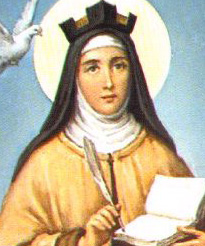Saint of the Day Online - St Teresa of Avila
Saint of the day online, Sunday, October 15, 2017
13-10-2017
Saint Name: Saint Teresa of Ávila
Place: Spain
Birth: 1515
Death: 4 October 1582
Feast: October 15
Saint Teresa of Ávila who was born on 28 March 1515 is also called Saint Teresa of Jesus was a prominent Spanish mystic, Roman Catholic saint, Carmelite nun and author during the Counter-Reformation and theologian of contemplative life through mental prayer. She was a reformer in the Carmelite Order of her time and the movement she initiated, later joined by Saint John of the Cross, eventually led to the establishment of the Discalced Carmelites, though neither she nor John was alive when the two orders separated.
Teresa's father was rigidly honest and pious, but he may have carried his strictness to extremes. Teresa's mother loved romance novels but because her husband objected to these fanciful books, she hid the books from him. This put Teresa in the middle -- especially since she liked the romances too. Her father told her never to lie but her mother told her not to tell her father. Later she said she was always afraid that no matter what she did she was going to do everything wrong.
When she was seven-years-old, she convinced her older brother that they should "go off to the land of the Moors and beg them, out of love of God, to cut off our heads there." They got as far as the road from the city before an uncle found them and brought them back. Some people have used this story as an early example of sanctity, but this author think it's better used as an early example of her ability to stir up trouble.
In 1622, forty years after her death, she was canonized by Pope Gregory XV, and on 27 September 1970 was named a Doctor of the Church by Pope Paul VI.[5] Her books, which include her autobiography (The Life of Teresa of Jesus) and her seminal work El Castillo Interior (trans.: The Interior Castle), are an integral part of Spanish Renaissance literature as well as Christian mysticism and Christian meditation practices. She also wrote Camino de Perfección (trans.: The Way of Perfection).
At 51, she felt it was time to spread her reform movement. She braved burning sun, ice and snow, thieves, and rat-infested inns to found more convents. But those obstacles were easy compared to what she face from her brothers and sisters in religious life. She was called "a restless disobedient gadabout who has gone about teaching as though she were a professor" by the papal nuncio. When her former convent voted her in as prioress, the leader of the Carmelite order excommunicated the nuns. A vicar general stationed an officer of the law outside the door to keep her out. The other religious orders opposed her wherever she went. She often had to enter a town secretly in the middle of the night to avoid causing a riot.
After her death, Saint Teresa was considered a candidate to become a national patron saint in Spain. A Santero image of the Immaculate Conception of El Viejo, said to have been sent with one of her brothers to Peru, Canonically crowned by Pope John Paul II on 28 December 1989 at the Shrine of El Viejo.[6] Pious Catholic beliefs also associate Saint Teresa with the Infant Jesus of Prague with claims of former ownership and devotion.